Lithium-Ion Battery Parameter Identification via Extremum Seeking Considering Aging and Degradation
Abstract
:1. Introduction
2. Materials and Methods
2.1. Battery Model
2.2. Extremum Seeking
3. Results
3.1. Evaluation Metrics
3.2. Test Scenarios
- The ground truth model and the estimation model have the same kernel, which belongs to the first cycle of the same cell (same cell and same aging).
- The ground truth kernel and the estimation kernel belong to the same cell but at different moments of its life (same cell and different aging).
- The ground truth kernel and the estimation kernel belong to different cells at different moments of their life (different cell and different aging).
3.3. Same Cell and Same Aging
3.4. Same Cell; Different Aging
3.5. Different Cell and Different Aging
4. Discussion
5. Conclusions
Author Contributions
Funding
Conflicts of Interest
References
- Han, X.; Lu, L.; Zheng, Y.; Feng, X.; Li, Z.; Li, J.; Ouyang, M. A review on the key issues of the lithium ion battery degradation among the whole life cycle. eTransportation 2019, 1, 100005. [Google Scholar] [CrossRef]
- Xiong, R.; Pan, Y.; Shen, W.; Li, H.; Sun, F. Lithium-ion battery aging mechanisms and diagnosis method for automotive applications: Recent advances and perspectives. Renew. Sustain. Energy Rev. 2020, 131, 110048. [Google Scholar] [CrossRef]
- Ambrose, H.; Kendall, A. Understanding the future of lithium: Part 1, resource model. J. Ind. Ecol. 2020, 24, 80–89. [Google Scholar] [CrossRef]
- Martin, G.; Rentsch, L.; Höck, M.; Bertau, M. Lithium market research—Global supply, future demand and price development. Energy Storage Mater. 2017, 6, 171–179. [Google Scholar] [CrossRef]
- Stringer, D.; Ma, J. Where 3 Million Electric Vehicle Batteries Will Go When They Retire. Bloom. Businessweek 2018, 27. Available online: https://www.bloomberg.com/news/features/2018-06-27/where-3-million-electric-vehicle-batteries-will-go-when-they-retire (accessed on 7 November 2021).
- Haram, M.H.S.M.; Lee, J.W.; Ramasamy, G.; Ngu, E.E.; Thiagarajah, S.P.; Lee, Y.H. Feasibility of utilising second life EV batteries: Applications, lifespan, economics, environmental impact, assessment, and challenges. Alex. Eng. J. 2021, 60, 4517–4536. [Google Scholar] [CrossRef]
- Hu, X.; Xu, L.; Lin, X.; Pecht, M. Battery Lifetime Prognostics. Joule 2020, 4, 310–346. [Google Scholar] [CrossRef]
- Li, K.; Zhou, P.; Lu, Y.; Han, X.; Li, X.; Zheng, Y. Battery life estimation based on cloud data for electric vehicles. J. Power Sources 2020, 468, 228192. [Google Scholar] [CrossRef]
- Li, S.; He, H.; Su, C.; Zhao, P. Data driven battery modeling and management method with aging phenomenon considered. Appl. Energy 2020, 275, 115340. [Google Scholar] [CrossRef]
- Plett, G.L. Extended Kalman filtering for battery management systems of LiPB-based HEV battery packs: Part 3. State and parameter estimation. J. Power Sources 2004, 134, 277–292. [Google Scholar] [CrossRef]
- Plett, G.L. Sigma-point Kalman filtering for battery management systems of LiPB-based HEV battery packs: Part 2: Simultaneous state and parameter estimation. J. Power Sources 2006, 161, 1369–1384. [Google Scholar] [CrossRef]
- Xia, B.; Lao, Z.; Zhang, R.; Tian, Y.; Chen, G.; Sun, Z.; Wang, W.; Sun, W.; Lai, Y.; Wang, M.; et al. Online Parameter Identification and State of Charge Estimation of Lithium-Ion Batteries Based on Forgetting Factor Recursive Least Squares and Nonlinear Kalman Filter. Energies 2018, 11, 3. [Google Scholar] [CrossRef] [Green Version]
- Giordano, G.; Klass, V.; Behm, M.; Lindbergh, G.; Sjöberg, J. Model-based lithium-ion battery resistance estimation from electric vehicle operating data. IEEE Trans. Veh. Technol. 2018, 67, 3720–3728. [Google Scholar] [CrossRef]
- Tang, X.; Liu, K.; Lu, J.; Liu, B.; Wang, X.; Gao, F. Battery incremental capacity curve extraction by a two-dimensional Luenberger–Gaussian-moving-average filter. Appl. Energy 2020, 280, 115895. [Google Scholar] [CrossRef]
- Yu, Q.; Xiong, R.; Lin, C.; Shen, W.; Deng, J. Lithium-Ion Battery Parameters and State-of-Charge Joint Estimation Based on H-Infinity and Unscented Kalman Filters. IEEE Trans. Veh. Technol. 2017, 66, 8693–8701. [Google Scholar] [CrossRef]
- Piao, C.; Li, Z.; Lu, S.; Jin, Z.; Cho, C. Analysis of real-time estimation method based on hidden markov models for battery system states of health. J. Power Electron. 2016, 16, 217–226. [Google Scholar] [CrossRef] [Green Version]
- Sahinoglu, G.O.; Pajovic, M.; Sahinoglu, Z.; Wang, Y.; Orlik, P.V.; Wada, T. Battery state-of-charge estimation based on regular/recurrent Gaussian process regression. IEEE Trans. Ind. Electron. 2017, 65, 4311–4321. [Google Scholar] [CrossRef]
- Yu, Z.; Xiao, L.; Li, H.; Zhu, X.; Huai, R. Model Parameter Identification for Lithium Batteries Using the Coevolutionary Particle Swarm Optimization Method. IEEE Trans. Ind. Electron. 2017, 64, 5690–5700. [Google Scholar] [CrossRef]
- Xiong, R.; Tian, J.; Shen, W.; Sun, F. A Novel Fractional Order Model for State of Charge Estimation in Lithium Ion Batteries. IEEE Trans. Veh. Technol. 2019, 68, 4130–4139. [Google Scholar] [CrossRef]
- Wei, C.; Benosman, M. Extremum seeking-based parameter identification for state-of-power prediction of lithium-ion batteries. In Proceedings of the 2016 IEEE International Conference on Renewable Energy Research and Applications (ICRERA), Birmingham, UK, 20–23 November 2016; pp. 67–72. [Google Scholar] [CrossRef]
- Coleman, M.; Lee, C.K.; Zhu, C.; Hurley, W.G. State-of-Charge Determination From EMF Voltage Estimation: Using Impedance, Terminal Voltage, and Current for Lead-Acid and Lithium-Ion Batteries. IEEE Trans. Ind. Electron. 2007, 54, 2550–2557. [Google Scholar] [CrossRef]
- Muthuswamy, B.; Banerjee, S. Introduction to Nonlinear Circuits and Networks; Springer: Berkeley, CA, USA, 2018. [Google Scholar]
- Anseán, D.; González, M.; Blanco, C.; Viera, J.C.; Fernández, Y.; García, V.M. Lithium-ion battery degradation indicators via incremental capacity analysis. In Proceedings of the 2017 IEEE International Conference on Environment and Electrical Engineering and 2017 IEEE Industrial and Commercial Power Systems Europe (EEEIC/I&CPS Europe), Milan, Italy, 6–9 June 2017; pp. 1–6. [Google Scholar] [CrossRef]
- Severson, K.A.; Attia, P.M.; Jin, N.; Perkins, N.; Jiang, B.; Yang, Z.; Chen, M.H.; Aykol, M.; Herring, P.K.; Fraggedakis, D.; et al. Data-driven prediction of battery cycle life before capacity degradation. Nat. Energy 2019, 4, 383–391. [Google Scholar] [CrossRef] [Green Version]
- Benosman, M.; Atinç, G.M. Multi-parametric extremum seeking-based learning control for electromagnetic actuators. In Proceedings of the 2013 American Control Conference, Washington, DC, USA, 17–19 June 2013; pp. 1914–1919. [Google Scholar] [CrossRef]
- Benosman, M. Extremum Seeking-Based Indirect Adaptive Control and Feedback Gains Auto-Tuning for Nonlinear Systems. 2015. Available online: https://www.merl.com/publications/docs/TR2015-009.pdf (accessed on 7 November 2021).
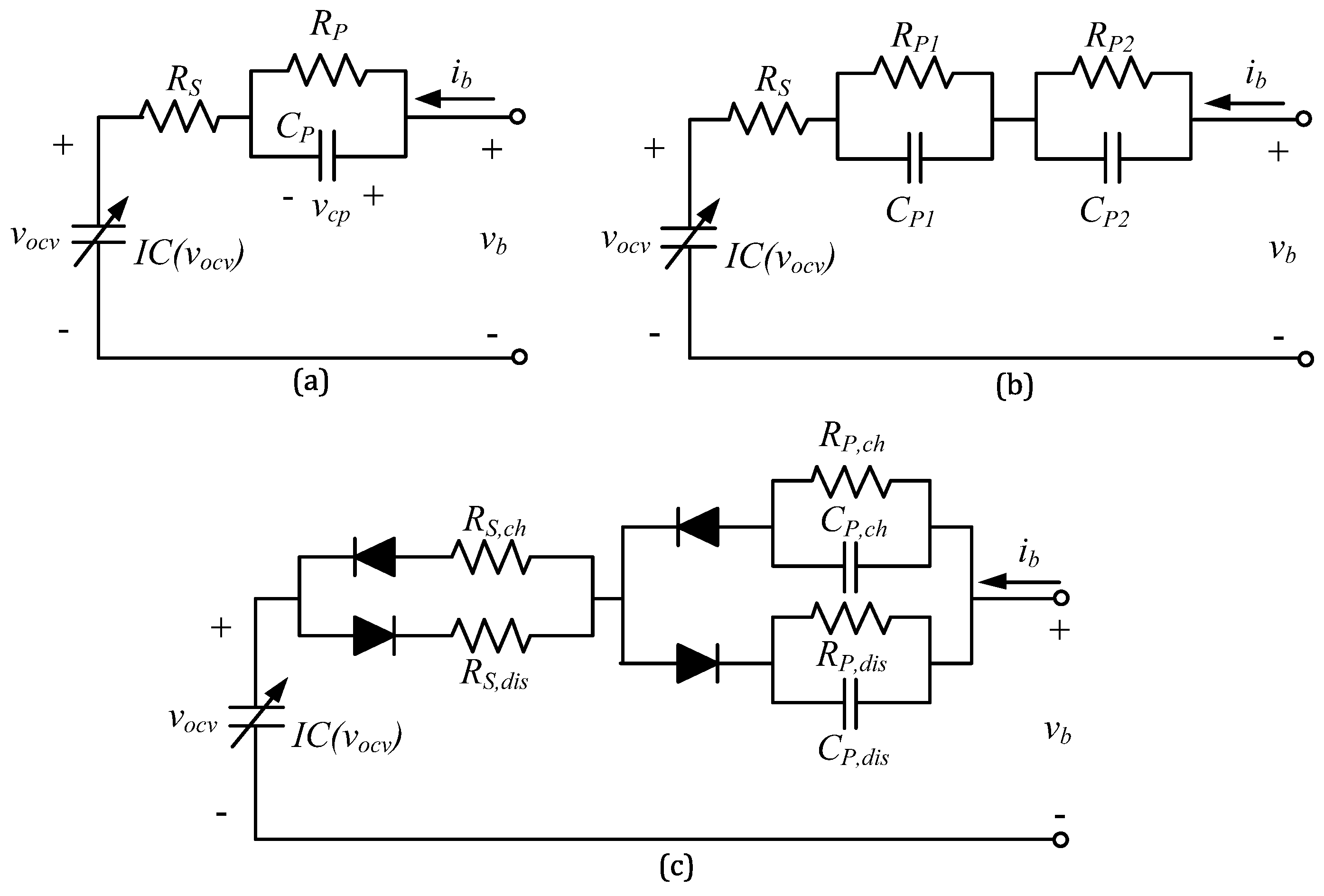
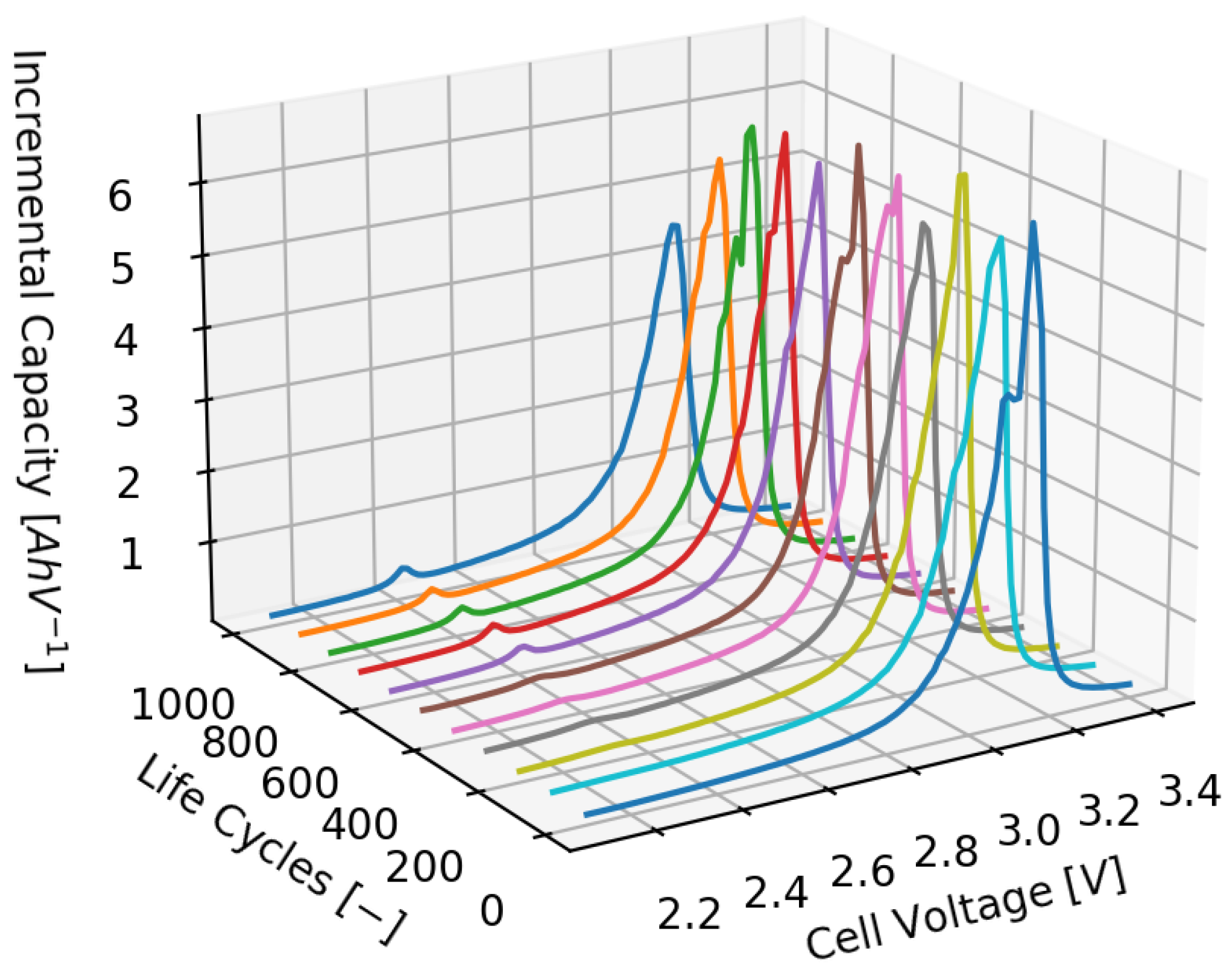

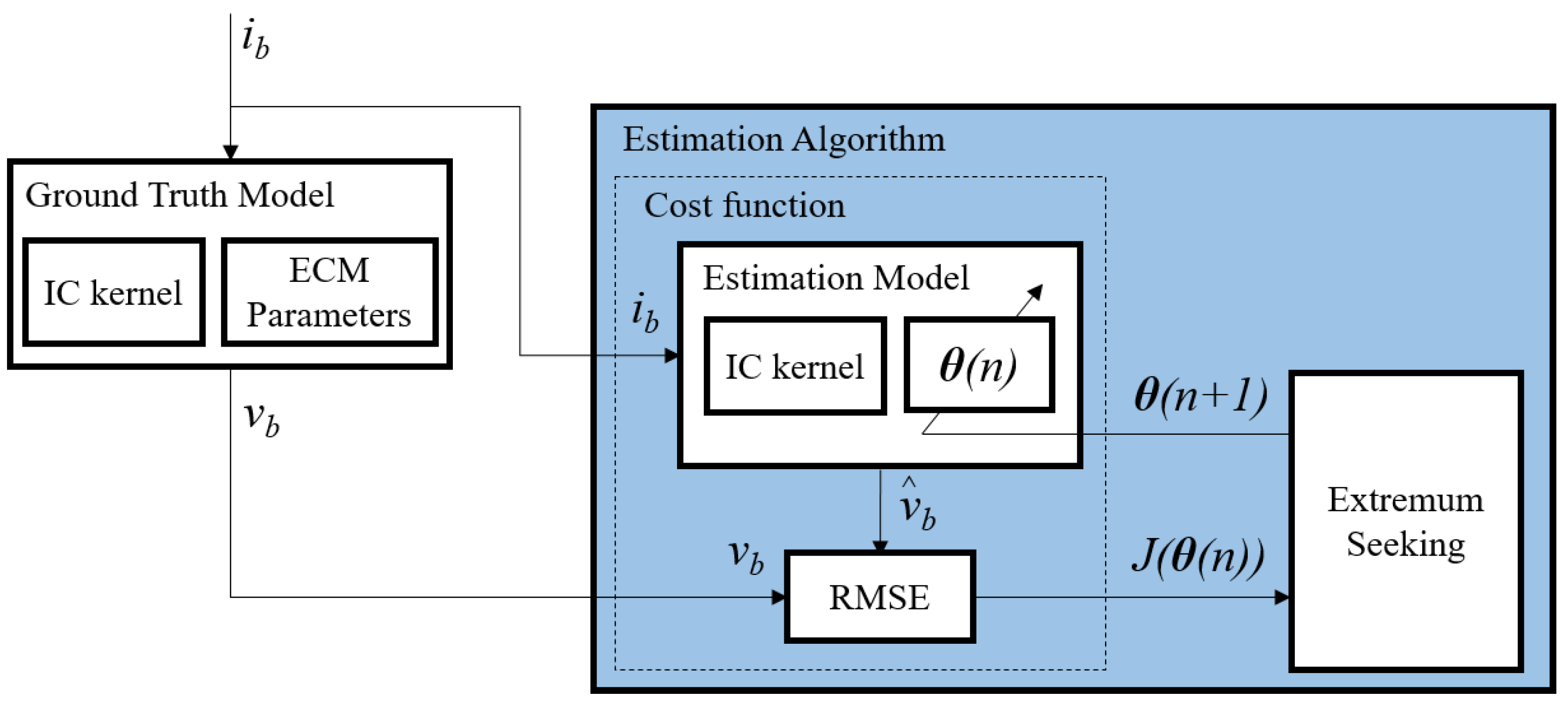
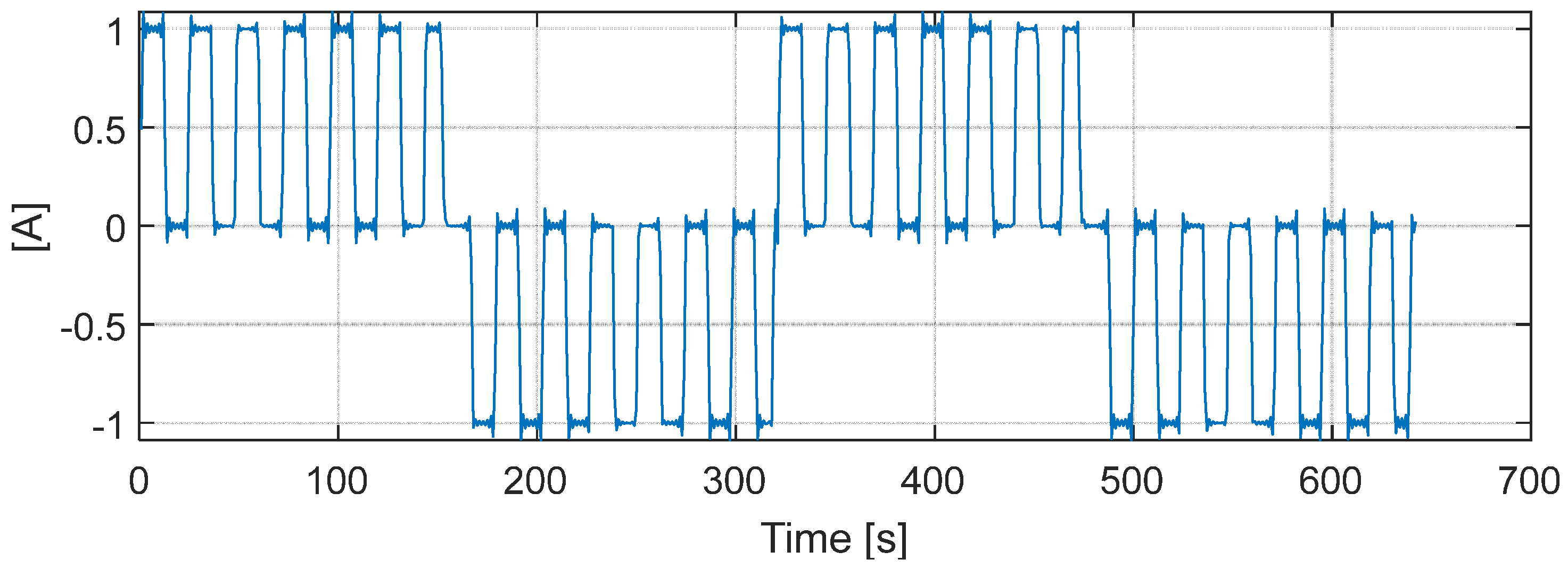
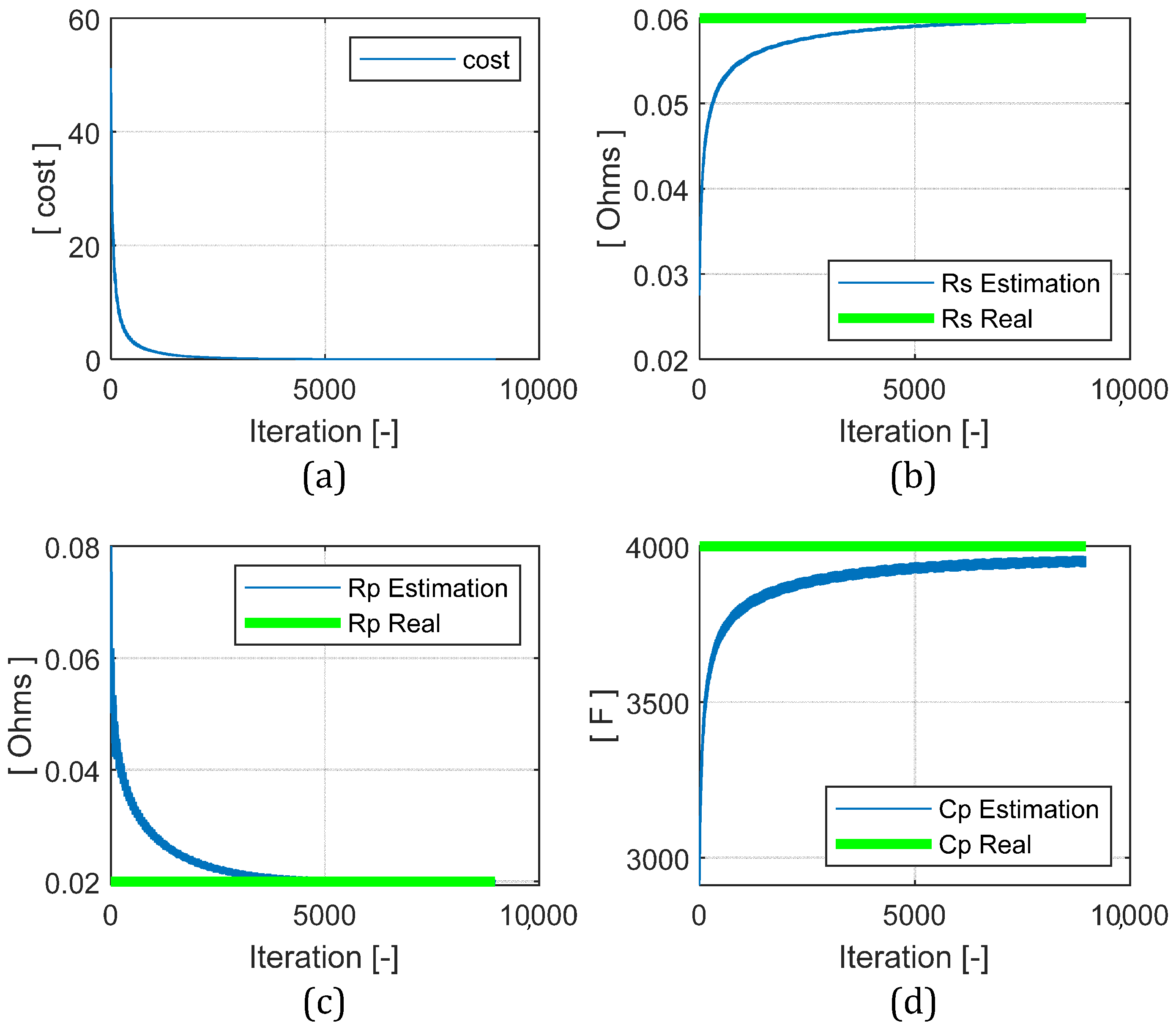
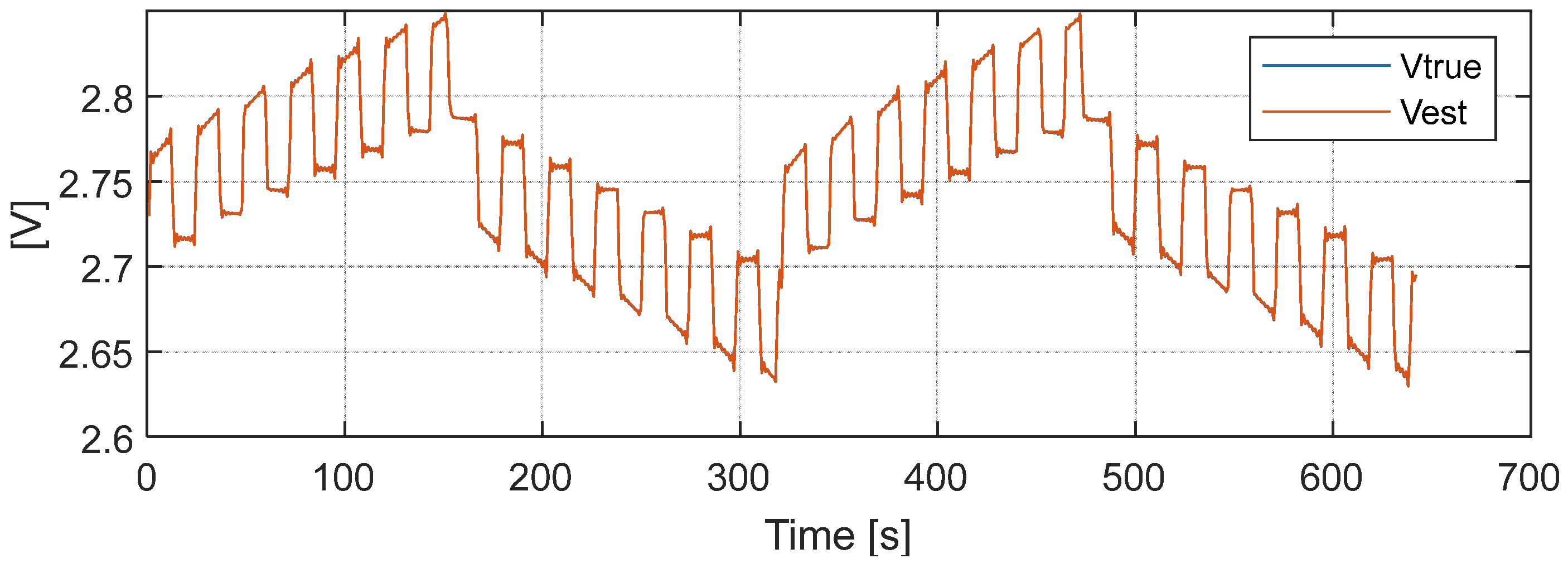
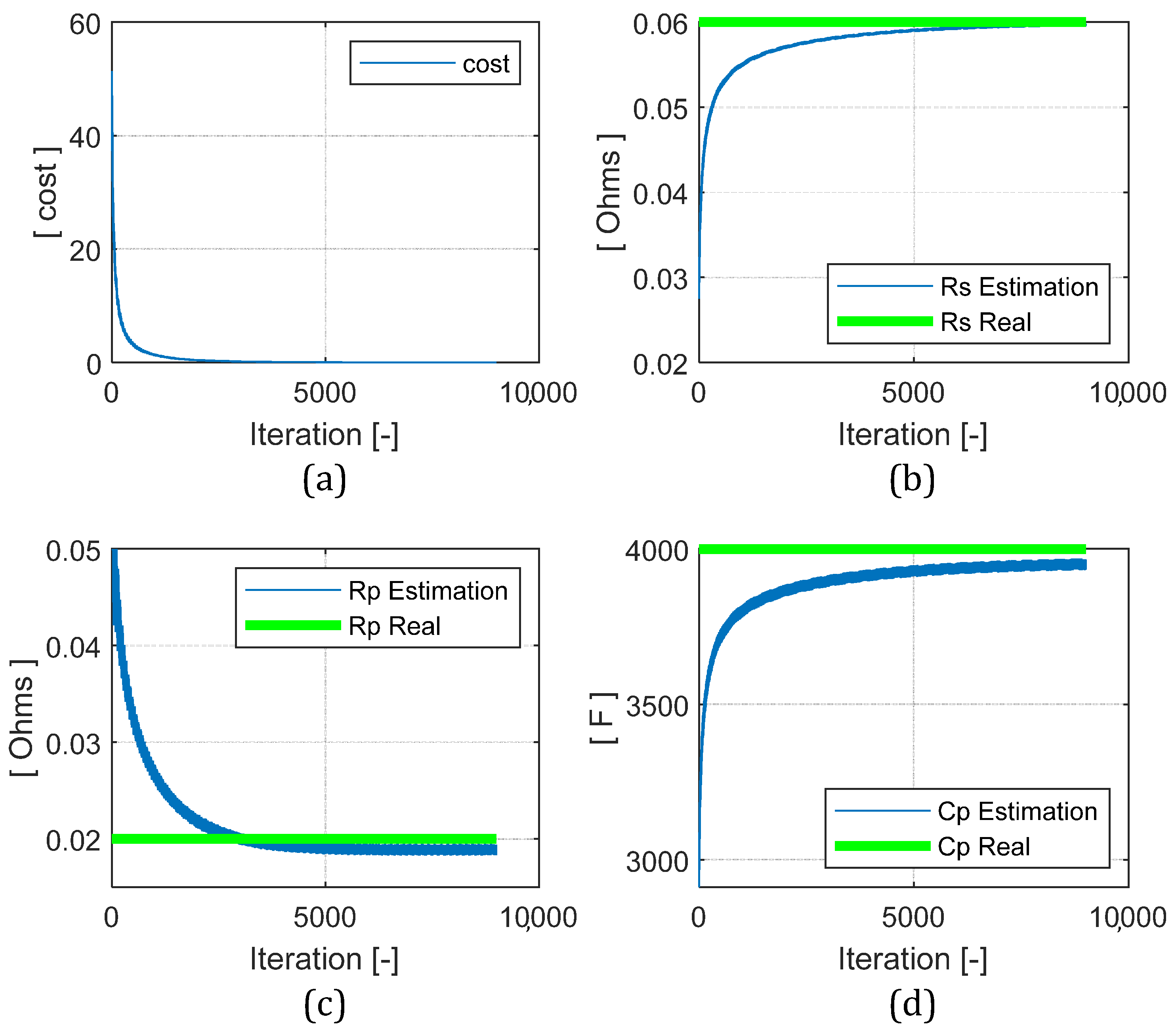

| Parameter | Value | Unit |
|---|---|---|
| 60 | m | |
| 20 | m | |
| 4000 | F |
| Parameter | Error | Unit | Metric |
|---|---|---|---|
| 0.28 | % | MRE | |
| 0.78 | % | MRE | |
| 0.82 | % | MRE | |
| Voltage | 0.1 | mV | RMSE |
| Parameter | Error | Unit | Metric |
|---|---|---|---|
| 0.34 | % | MRE | |
| 3.13 | % | MRE | |
| 0.9 | % | MRE | |
| Voltage | 0.2 | mV | RMSE |
| Parameter | Error | Unit | Metric |
|---|---|---|---|
| 1.6 | % | MRE | |
| 79.5 | % | MRE | |
| 0.32 | % | MRE | |
| Voltage | 5.2 | mV | RMSE |
Publisher’s Note: MDPI stays neutral with regard to jurisdictional claims in published maps and institutional affiliations. |
© 2021 by the authors. Licensee MDPI, Basel, Switzerland. This article is an open access article distributed under the terms and conditions of the Creative Commons Attribution (CC BY) license (https://creativecommons.org/licenses/by/4.0/).
Share and Cite
Sanz-Gorrachategui, I.; Pastor-Flores, P.; Bono-Nuez, A.; Ferrer-Sánchez, C.; Guillén-Asensio, A.; Bernal-Ruiz, C. Lithium-Ion Battery Parameter Identification via Extremum Seeking Considering Aging and Degradation. Energies 2021, 14, 7496. https://doi.org/10.3390/en14227496
Sanz-Gorrachategui I, Pastor-Flores P, Bono-Nuez A, Ferrer-Sánchez C, Guillén-Asensio A, Bernal-Ruiz C. Lithium-Ion Battery Parameter Identification via Extremum Seeking Considering Aging and Degradation. Energies. 2021; 14(22):7496. https://doi.org/10.3390/en14227496
Chicago/Turabian StyleSanz-Gorrachategui, Iván, Pablo Pastor-Flores, Antonio Bono-Nuez, Cora Ferrer-Sánchez, Alejandro Guillén-Asensio, and Carlos Bernal-Ruiz. 2021. "Lithium-Ion Battery Parameter Identification via Extremum Seeking Considering Aging and Degradation" Energies 14, no. 22: 7496. https://doi.org/10.3390/en14227496
APA StyleSanz-Gorrachategui, I., Pastor-Flores, P., Bono-Nuez, A., Ferrer-Sánchez, C., Guillén-Asensio, A., & Bernal-Ruiz, C. (2021). Lithium-Ion Battery Parameter Identification via Extremum Seeking Considering Aging and Degradation. Energies, 14(22), 7496. https://doi.org/10.3390/en14227496






